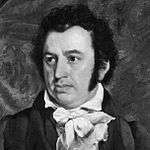George Stott
| ||||||||
George Stott (1835-1889) was a British Protestant Christian missionary to China with the China Inland Mission.
Despite physical disabilities, Stott was a highly effective mission leader. In China he is widely credited, alongside William Edward Soothill, for laying the groundwork for the large number of Christian adherents in Wenzhou, Zhejiang Province.[1]
Early Life and Education
Born in Belhelvie, Aberdeenshire, Scotland, the son of John Stott, a crofter, and his wife, Jane Anderson.[2] Stott initially worked in agriculture, but due to a serious knee injury at the age of nineteen, a subsequent leg amputation and evangelical Christian conversion, he became a schoolmaster and active member of the Free Church of Scotland.
Mission Work in China
In early 1865, Stott learnt that James Hudson Taylor was looking to recruit pioneer missionaries for his non-denominational China Inland Mission. Stott was duly hired, provided with a new artificial leg and set sail for China on October 4, 1865. Arriving in Shanghai on February 6, 1866, Stott quickly relocated to the port city of Wenzhou in Zhejiang province, where Christian teaching had been previously unknown. The oldest church in the city, Chengxi Christian Church, still stands as a testimony to his work. As a result of the ongoing influence of the message of Christ first brought there by Stott, Wenzhou is known today as the “Jerusalem of China” because in the entire Wenzhou Municipality, which has 6 million inhabitants, there are more than 600,000 evangelical Protestants – 10% of the population.

His wife Grace Ciggie wrote of his early life:[3]
"Mr. Stott had been brought up to farm work, but when he was about nineteen years of age he slipped on the road and knocked his knee against a stone. This simple accident resulted in white swelling, which, two years later, necessitated the amputation of the left leg. For nine months he lay a helpless invalid, and it was during this time that the Lord graciously saved his soul. So far he had been careless and indifferent to the love of God in Christ Jesus, but now, in his helpless condition, and what seemed his ruined future, how precious that love became! After his recovery he began to teach in a school, and had been thus employed several years when he first heard of China's needs through a friend, who himself was going out. "

"In accepting Mr. Stott for mission work, Hudson Taylor manifested faith, for no Society would have sent an amputee to such a country to pioneer work, and Mr. Stott often referred with gratitude to Mr. Taylor's acceptance of him. When asked why he, with only one leg, should think of going to China, his remark was,
" I do not see those with two legs going, so I must." "
Stott died on April 21, 1889 on Easter morning, at half-past six.
References
- ↑ Anderlini, Jamil (7 November 2014). "The Rise of Christianity in China". Financial Times. Retrieved 13 November 2014.
- ↑ Pollock, John (2004). "Stott, George (1835-1889)" ((subscription or UK public library membership required)). Oxford Dictionary of National Biography. Oxford: Oxford University Press. doi:10.1093/ref:odnb/49394. (subscription required (help)).
- ↑ Mrs. Grace (Ciggie) Stott (1897). Twenty-six Years of Missionary Work in China. American Tract Society. pp. 2–3.
Further reading
- “Twenty-Six Years of Missionary Work In China” by Grace Ciggie Stott; 1898
- Historical Bibliography of the China Inland Mission
- List of China Inland Mission missionaries in China
- Biographical Dictionary of Chinese Christianity

